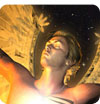Harmonic Interference Theory is a set of thirty-four principles that explain music perception using the underlying physics of a harmonic standing wave. Based on a mathematical balance between resonance and damping found in all coherently vibrating mediums, perceptual qualities in music can be modeled organically using what is called a ‘reflective interference function’ between the harmonic and Fibonacci series.
 This organic model is then used to explain how musical timbre and harmony can be pattern matched recursively as cymatic geometries in the ear and brain. While the theory deals specifically with the question of music perception, the same universal principles can be used to explain other natural phenomena, such as how star systems harmonically self-organize, how matter self-organizes into living carbon-water crystals and how self-awareness emerges from physiological resonance.
This organic model is then used to explain how musical timbre and harmony can be pattern matched recursively as cymatic geometries in the ear and brain. While the theory deals specifically with the question of music perception, the same universal principles can be used to explain other natural phenomena, such as how star systems harmonically self-organize, how matter self-organizes into living carbon-water crystals and how self-awareness emerges from physiological resonance.
In general, Harmonic Interference Theory represents a unified natural philosophy using Pythagorean harmonic science as a focusing extension to the quantum holographic model of Bohmian physics.
Content courtesy of Richard Merrick
Read Richard Merricks Blog Interference Theory










